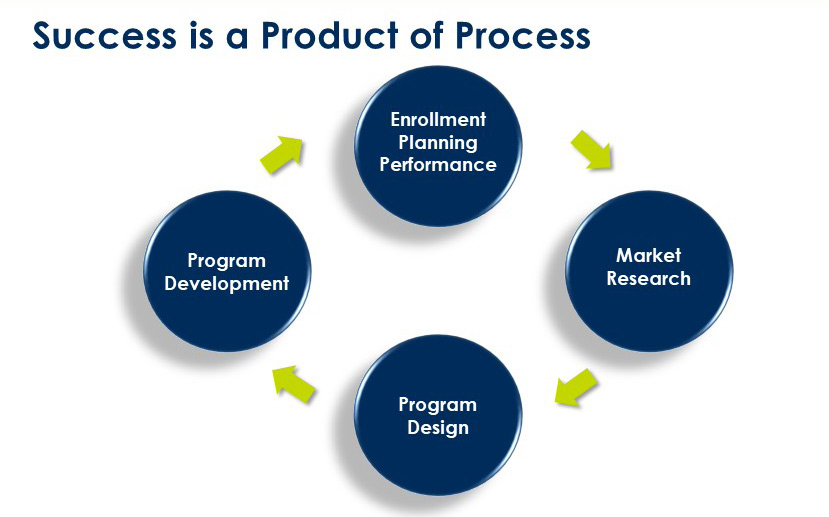enrollment
Building for Academic Excellence: The Academic Program Planning Cycle

Earlier this spring, I had the pleasure of presenting with Dr. Jenna Templeton, vice president of academic affairs at Chatham University, and Charles Ramos, vice president for graduate and online solutions at RNL. Our goal was to connect the dots between market research, program design and development, and enrollment management. (You can watch our presentation and all the others from the 2022 Graduate and Online Summit here.)
I’m sure many of us have been in the room when a new academic program planning idea bubbles up and the conversation starts, “I was talking with the CEO at Blah, Blah Inc., and she feels there is an opportunity if we offer a degree in XYZ.” Or a faculty champion steps forward with a brilliant program idea that has not been market tested. In my years working in enrollment and academic administration, one of the consistent short-comings has been a lack of connection between market feasibility research and new program creation. Much like any quality strategic planning process, academic program planning requires ongoing assessment of market conditions, quality and relevancy of the program, and honest analysis of enrollment expectations and performance. It is a cyclical process that when done well, will ensure your program portfolio is attractive to prospective students and delivers a quality learning experience.

MARKET RESEARCH: Selecting and maintaining relevant programs
A data-informed decision regarding which programs to launch and keep in the institutional portfolio is a must. In a resource-constrained environment, colleges and universities must make difficult decisions about the programs that should be offered. There are a number of data sources, resources, and tools that can contribute to a well-rounded understanding of opportunity in your market, such as:
- IPEDS—a trailing indicator of conferrals and competitors
- National Student Clearinghouse Resource Center—real-time data regarding program enrollment
- Bureau of Labor Statistics—a leading indicator of the labor market
- Emsi/Burning Glass—real-time data about job postings, regional economic indicators, high demand skills, and hiring organizations
- Digital search tools from Google or Bing—measures of search demand and interest
Not all programs need to be market driven. Some may be in the portfolio to meet a key missional object. That’s great! But a realistic understanding of potential performance for enrollment will make everyone’s life a lot easier.
PROGRAM DESIGN: Know your learners
Now that you know the right programs for your market, the next step is engaging campus faculty in program design. Determining and securing the right faculty to support the program, whether full-time or contingent, is an important step to understanding the viability of your new program. If subject matter experts are hard to find or expensive to engage, this may not be the program for your campus.
Structural decisions about course length, learning outcomes and degree requirements, and modality will signal to the market the kinds of learners you expect to attract to your program. Remember: programs that are designed the way they have always been designed for traditional learners will not “sell” if your target for the new program is some other demographic.
As these decisions are being made, I strongly recommend engaging the financial aid and registrar’s offices early and often. Decisions regarding the program’s price point and ways students can finance their education are vital to the future success of the program.
PROGRAM DEVELOPMENT: Investments in the learning experience
No matter the modality, an investment in instructional design and faculty collaboration will strengthen your program’s quality—which will then result in student satisfaction. Ensure each course in the program aligns to the overall programmatic outcomes and that each faculty member teaching in their program understands their contribution to the overarching learning goals.
Students should also clearly understand the “why” for a given course (this is SO often the missing piece). When design is done exceptionally well, the curriculum should also help connect the dots from learning to having the much desired leg up in the career path of choice. Students should be able to say to employers, “Here’s what I learned in my program and here’s a demonstration of that work that will advance our organizational objectives by…”
Ongoing evaluation of the relevancy of the content of the program, upskilling course requirements and assignments, and leveraging industry experts along with your faculty will result in attractive programs that clearly demonstrate an ROI for your students. (See our white papers on upskilling and leveraging academic/industry partnerships for more on these topics.).
ENROLLMENT PLANNING/PERFORMANCE: Setting Expectations
The last area of academic program planning is setting expectations for expected enrollment. To successfully set targets (and the related revenue potential for the institution) you will need to understand the costs associated with lead acquisition and the performance of the enrollment funnel from inquiry to enrollment. Ensuring you have the right staffing structures and technologies to engage inquiries with your program is key. If your competitors are connecting with prospects in a timely and engaging way while you are waiting to send your first “thanks for your inquiry” email, your marketing investment is wasted.
It is also important to allow time for the program to build before expecting a return on the campus investment in the program. Even with a known institutional brand or a high demand program, allow yourself a good six-to-nine months of marketing before seeing section sizes that will bring net revenue to your program. Be willing to have a start or two as a loss leader while the funnel builds. By making the right choices in market research, program development and design, and your enrollment processes, you will see results.
As the program ages, return to market research to ensure it is still viable and that your learning outcomes align with market expectations. Adjust and adapt as needed to ensure an excellent learning experience for students. And when the time comes, be comfortable with the reality that not all programs have a shelf-life and that in making the decision to sunset programs that are no longer viable, you are opening up resources to support programs that will bring new energy to your campus.
These are areas where RNL can greatly help you. We can help you conduct market research that will guide your decision making in the right direction, develop high quality instructional design, and engage and enroll the students you want. My colleagues and I are happy to talk with you, simply contact us and we’ll set up a time to talk.
Talk with our graduate and online experts about program planning
Find out how we can help you prioritize programs by growth potential, assess the market demand for new programs, and develop personas of potential students. Ask for your complimentary consultation.
